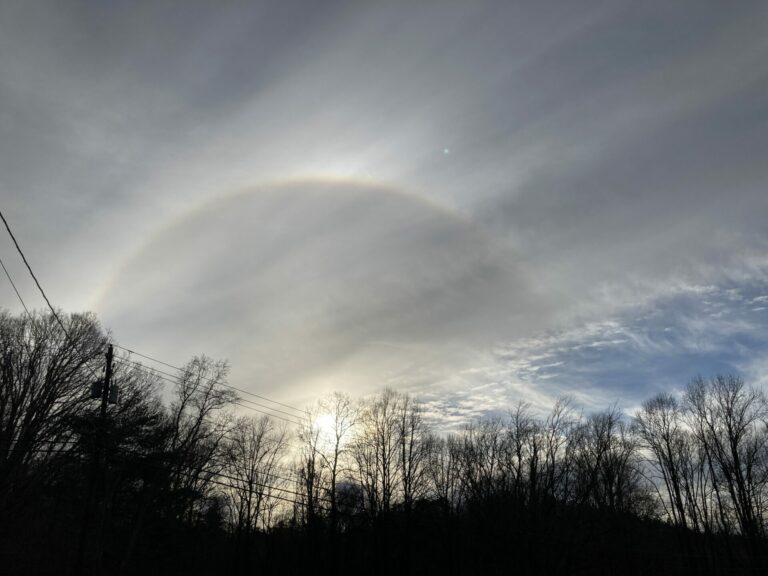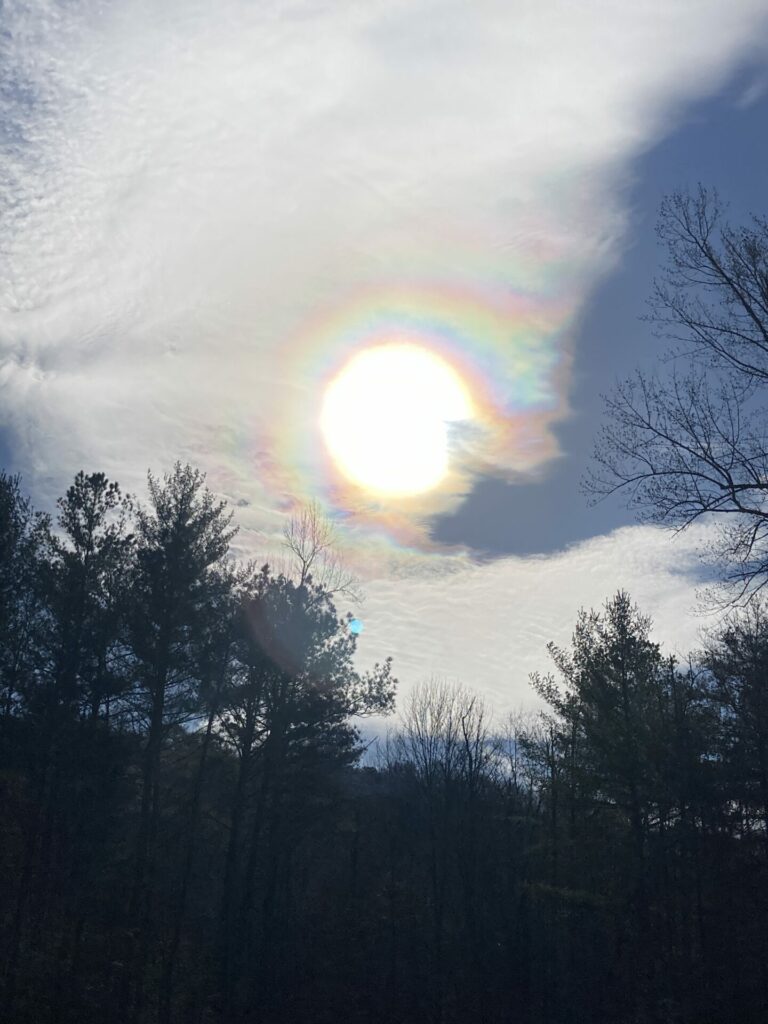On the Road is a weekday feature spotlighting reader photo submissions.
From the exotic to the familiar, whether you’re traveling or in your own backyard, we would love to see the world through your eyes.
SkyBluePink
Three days of magnificent sky shows.

Precursor

Colors with wild clouds

Beginning

December 21, 2023
Solstice Sunbow

third day of Sunbows

More Sunbow

An upside down Sunbow or a Sunbow smile?

Piece de resistance of Sunbows
Piece de resistance of Sunbows

Baud
Wow.
eclare
Oh wow! Where did you take these photos?
MattF
There’s a whole menagerie of lights you can get under perfect circumstances. APOD sometimes offers images of the spectacular sky-lights you can get, particularly from ice particles. Here’s a recent one.
Tom Hamill
Ok, from your atmospheric scientist lurker, so you know what you’re looking at: the first few are called “sundogs” and are a refraction phenomenon through hexagonal plate ice crystals that tend to lie horizontally. https://en.wikipedia.org/wiki/Sun_dog. These are typically associated with the leading edge of a warm front high aloft. As the sky gets filled with more pencil-shaped crystals with random orientations, you get another refraction phenomenon called a 22-degree halo, https://en.wikipedia.org/wiki/22%C2%B0_halo in photos 3 to 6. The pretty rainbow-colored one is called a circumzenithal arc, described more here: https://en.wikipedia.org/wiki/Circumzenithal_arc . The last picture is called iridescence https://en.wikipedia.org/wiki/Iridescence and is a diffraction phenomenon, very different, and associated with the diffraction of light through relatively uniform-size water droplets.
Tom Hamill
The bit of brightening at the top of the halo in the fifth picture is called an upper-tangent arc: https://en.wikipedia.org/wiki/Tangent_arc .
Betty
Thanks to Skybluepink for the pictures and to Tom for the explanation.
SkyBluePink
@eclare: Western NC into GA
OzarkHillbilly
@Tom Hamill: Boy, you really know how to take all the fun out of saying “SUNBOW!” ;-) ;-)
SkyBluePink
@Tom Hamill: I stand corrected.
And here I thought they were the SkyGod’s acknowledgement of my end of year rituals.
KSinMA
Amazing photos. Thanks!
Trivia Man
@SkyBluePink: por que no los dos?
Anyway
Neat! Both the pictures and the scientific explanations. Thanks SkyBluePink and Tom.
SteveinPHX
@Tom Hamill: Thank you for technical explanations! I forwarded photos and your additions to my son in Australia. He’s working on a doctorate in astrophysics, but loves this stuff as well.
JeanneT
Stunning! Thanks SkyBluePink!
Spanish Moss
Gorgeous! I didn’t know that such a thing existed. Love the pictures and the scientific explanations.
WaterGirl
@Betty: Not reading past the fist sentence in the explanation. :-)
I prefer to think of them as magic! And i don’t want to stop looking at any of these, ever. Okay, I could walk away from the one with the stop sign.
But otherwise, sit me down in front of a slideshow to watch these on repeat, and I will quit my day job.
pieceofpeace
Thanks for starting the day beautifully, both of you…
Betsy
I have seen a circumzenithal arc (like in your next-to-last picture) just a couple of times.
Your last photo might be “cloud iridescence” and I’ve been lucky to see that a few times.
Sundogs (like in the other photos) are more common but much appreciated too.
Now a hint I’ve learned from other skywatchers — whenever you see a pretty good sundog, be sure to look up as well, because that’s a good chance to notice a circumzenithal arc or other associated prismatic effects. People miss a lot of them because we are not in the habit of looking up in the sky.
munira
How amazingly cool. Thanks for sharing.
Matt McIrvin
@WaterGirl: If you know the explanations it makes it easier to look for them and see them in real life!
cope
Very nice pictures, thank you. So much goes on in the sky, day and night, that we don’t ordinarily think to look for and appreciate. When I taught high school astronomy, getting the kids to just look up was one of my major goals.
@Betsy: The same tip applies to crepuscular rays coming from the setting Sun. Often, if you turn and look 180 degrees from the setting Sun, you might well catch anti-crepuscular rays as well.
Thanks again for the pictures, SkyBluePink.
Matt McIrvin
@Betsy: There are also circumhorizontal arcs, which are like the circumzenithal arc but appear *below* the Sun, and only when the Sun is quite high in the sky in summer. They’re sometimes called “fire rainbows” though this is pretty much exclusively an Internet-meme term as far as I can tell. They are rarer and I’ve only seen them a couple of times.
And the horizontal line stretching off to the left and right from the sundogs in the fourth and sixth pictures is called a parhelic circle. On one occasion I’ve seen that circling the whole sky.
Torrey
Wonderful pictures, and I appreciate the explanations and the tips on where to look next when one sees one of these phenomena. Much thanks!
Matt McIrvin
Often when you see a nice halo display, it’s a sign of some kind of unsettled weather coming in the next 24 hours or so, because these ice crystals often abound high up in advance of a weather system. I remember seeing some good ones the day before Hurricane Sandy came up the East Coast.
StringOnAStick
@MattF: This APOD has each of the “bow” features labeled and explained in that amazing photo in the link you posted, but only if your cursor hovers over the photo. people, go look at MattF’s link!
way2blue
Huh! Never imagined such a wonderful light show. Sundogs, sunbows, up-side-down rainbows. Very cool.
WaterGirl
@StringOnAStick: Thanks for the hot tip. That is amazing! All those labels are great.
Pete Mack
Sun halo *and* (small) sun dogs in #2. Splendid photos.